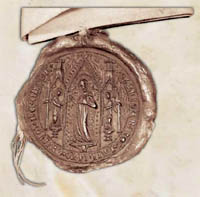 The history of the archives is closely related to the activities of the municipal office and therefore even the basis of the oldest documents are charters, letters, books and writings, created in the municipal office or given to the city. In the Middle Ages, the right to record and ensure the correspondence of the city, to record into municipal books and to care about the archives was entrusted to lawyers. The archives was not accessible to the public in the past, it was even prohibited to show the original or a transcript of a document preserved at the the archives. Especially charters, which dealt with municipal laws, required a separate permission from the city council. In the Middle Ages, entry into the archives was carried out by a meeting of the reeve, lawyer and archivist. The cabinet, where the most valuable documents were stored, could originally be opened with 4 keys and 2 locks. Each access was always recorded. The Košice City Archives was a domestic archives and served to fulfill the requirements of the city above all. Especially documents supposedly indicating priviliges and rights of townsmen of Košice remained from the age of feudalism and present only a fragment of the original writing material. Other documents, unnecessary for everyday work, had been taken out and kept in a place, where they did not hinder and therefore often got lost.
The history of the archives is closely related to the activities of the municipal office and therefore even the basis of the oldest documents are charters, letters, books and writings, created in the municipal office or given to the city. In the Middle Ages, the right to record and ensure the correspondence of the city, to record into municipal books and to care about the archives was entrusted to lawyers. The archives was not accessible to the public in the past, it was even prohibited to show the original or a transcript of a document preserved at the the archives. Especially charters, which dealt with municipal laws, required a separate permission from the city council. In the Middle Ages, entry into the archives was carried out by a meeting of the reeve, lawyer and archivist. The cabinet, where the most valuable documents were stored, could originally be opened with 4 keys and 2 locks. Each access was always recorded. The Košice City Archives was a domestic archives and served to fulfill the requirements of the city above all. Especially documents supposedly indicating priviliges and rights of townsmen of Košice remained from the age of feudalism and present only a fragment of the original writing material. Other documents, unnecessary for everyday work, had been taken out and kept in a place, where they did not hinder and therefore often got lost.
The first arrangement of the archives in the 16th century to the mid-18th century
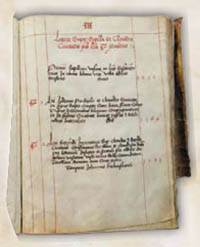 Johannes Scheutczlich (1503-1512) arranged and assorted the accumulated archival material according to the requirements of the city's legal relationships. He wrote an elenchus to the arranged documents and named it "Elenchus Jurium et Privilegiorum Civitatis Cassoviensis" ("A list of laws and priviliges of the city of Košice"), wherein he marked each script with a red press-mark, a short apt regesta and the year of issue. The material was thematically and chronologically arranged into 43 groups according to the generality principle. Gothic italics is used in the elenchus. The language is mostly Latin and occassionaly German.
Johannes Scheutczlich (1503-1512) arranged and assorted the accumulated archival material according to the requirements of the city's legal relationships. He wrote an elenchus to the arranged documents and named it "Elenchus Jurium et Privilegiorum Civitatis Cassoviensis" ("A list of laws and priviliges of the city of Košice"), wherein he marked each script with a red press-mark, a short apt regesta and the year of issue. The material was thematically and chronologically arranged into 43 groups according to the generality principle. Gothic italics is used in the elenchus. The language is mostly Latin and occassionaly German. 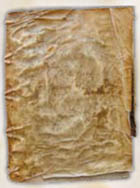 In today's understanding, it is the oldest archival arangement of the city's most valuable documents and it was undoubtedly created out of the needs of the municipal office. The elenchus of Johannes Scheutczlich, initially a lawyer, later a consul and a reeve at last, described those documents, which he needed to refer to in the royal court, in negotiations with the citizens or in cases with the merchants.
In today's understanding, it is the oldest archival arangement of the city's most valuable documents and it was undoubtedly created out of the needs of the municipal office. The elenchus of Johannes Scheutczlich, initially a lawyer, later a consul and a reeve at last, described those documents, which he needed to refer to in the royal court, in negotiations with the citizens or in cases with the merchants. The "Elenchus" is unique in its nature, even though its no longer valid, because no other inventories remained from that age. Due to the fact, that it is written on parchment, it was preserved also with its dust cover nearly undamaged. At the beginning of the 16th century, the Košice City Archives were very transparently equipped for that age. The facility had access to an archival apparatus and a custom room with cabinets, where chests and boxes assorted by color were kept.
The second arrangement 1756 - 1829
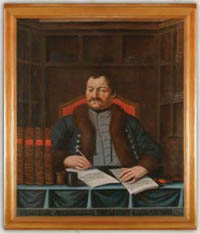 The municipality itself was the initiator of the second arrangement. Since the original arrangement could not bear the enlarging written agenda of the city anymore, the municipality charged two chancellors after the 1738 elections, namely Ján Polyáki and F.A. Schwartzenbach, with the responsibility to catalog the large amount of material.
The municipality itself was the initiator of the second arrangement. Since the original arrangement could not bear the enlarging written agenda of the city anymore, the municipality charged two chancellors after the 1738 elections, namely Ján Polyáki and F.A. Schwartzenbach, with the responsibility to catalog the large amount of material. František Anton Schwartzenbach, brought up in a patrician and clerical family, proceeded through many ranks of a clerk's career, ranging from vice-lawyer to senator, while fulfilling the role of the city captain as a secondary position. He developed a project of planned arrangement of the Košice Archives, which is valid to this day. His work is documented by two parts of the inventory named "Tabularium metropolitanae in Superiori Hungaria regiae et liberae civitatis Cassoviensis" ("Archives of the Independent Royal City of Košice, Metropolis of Upper Hungary"). Tabularium I. contains the records of the most valuable part of the archives, called the Secret Archive - "Archivum secretum". Tabularium II. has two parts. Part "A" contains the records from years 1256 - 1700. Part "B" contains volumes 1701 - 1737 and amendments from the years 1319 - 1737. The first part of the inventory is beautifully decorated. Two angels hold a cover with the title "Tomus primus" while the city's coat-of-arms from the year 1502 is risen above it. Indices in three volumes (A-F, G-P, Q-Z) were carried out to accompany part A. Part "B" is related to two volumes of indices (A-L, M-Z).
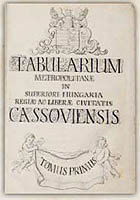 F. A. Schwartzenbach arranged the archives on the principle of pertinence in a chronological order. As compared to Scheutzlich and taking into consideration a larger amount of documents, he split the main groups into subgroups, while only the subgroups contained a password. A very well readable humanistic italics is used as the font. An untimely death on the 8 August 1764 did not allow him to finish his work. At this time, there's no point for justification of his work. It is enough to say that his inventory has been used by the archives for over 200 years.
F. A. Schwartzenbach arranged the archives on the principle of pertinence in a chronological order. As compared to Scheutzlich and taking into consideration a larger amount of documents, he split the main groups into subgroups, while only the subgroups contained a password. A very well readable humanistic italics is used as the font. An untimely death on the 8 August 1764 did not allow him to finish his work. At this time, there's no point for justification of his work. It is enough to say that his inventory has been used by the archives for over 200 years. 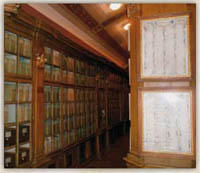 In the wake of Schwartzenbach, a registrar initially and later a lawyer and senator, Jozef Schram continued working on the inventory following the death of Schwartzenbach. His inventory, the Tabularium III., also called "Supplementum Schramianum", contains documents covering the years 1326 - 1734. Schram carried out a seven-volume index accompanying the registrar's files. His co-worker Ondrej Hudák further cataloged 34 classes of indices. Archival tools carried out by these archivists greatly exceeded the requirements of their age with their standard and serve up to this day. Archival documents from the large historical building were assorted, made accessible and a basic informative report was filed about them. The continuation of the Tabularium is the City Council Registry from the year 1738. Solely the Košice City Archives has a well-preserved complete municipality registry until nowadays. The collections merely make up the archival material created by the natural activity of the municipality.
In the wake of Schwartzenbach, a registrar initially and later a lawyer and senator, Jozef Schram continued working on the inventory following the death of Schwartzenbach. His inventory, the Tabularium III., also called "Supplementum Schramianum", contains documents covering the years 1326 - 1734. Schram carried out a seven-volume index accompanying the registrar's files. His co-worker Ondrej Hudák further cataloged 34 classes of indices. Archival tools carried out by these archivists greatly exceeded the requirements of their age with their standard and serve up to this day. Archival documents from the large historical building were assorted, made accessible and a basic informative report was filed about them. The continuation of the Tabularium is the City Council Registry from the year 1738. Solely the Košice City Archives has a well-preserved complete municipality registry until nowadays. The collections merely make up the archival material created by the natural activity of the municipality.The period of 1834 - 1951
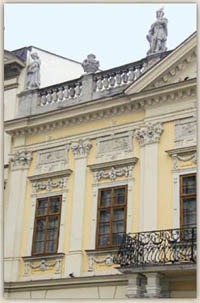 O. R. Halaga called this period the age of depression. The praiseworthy work of appointed archivists did not have any followers for many years to come. From one lawyer to another, the archives were passing by their hands without any official consignment. The then citizen's tribune Ján Kloczko appealed to the municipality, that it is necessary to take care about the archives and create a permanent clerical place for it because the treasures of every city are preserved in its archives. The city council accepted his proposal. Therefore we might be able to talk about an independent archival office since 1846. The newly established office not only replaced the archives for the city, but also the filing room and the register office, which seemed to be the detriment of the cause. Hence, the archivist had to take care about the museum pieces and books.
O. R. Halaga called this period the age of depression. The praiseworthy work of appointed archivists did not have any followers for many years to come. From one lawyer to another, the archives were passing by their hands without any official consignment. The then citizen's tribune Ján Kloczko appealed to the municipality, that it is necessary to take care about the archives and create a permanent clerical place for it because the treasures of every city are preserved in its archives. The city council accepted his proposal. Therefore we might be able to talk about an independent archival office since 1846. The newly established office not only replaced the archives for the city, but also the filing room and the register office, which seemed to be the detriment of the cause. Hence, the archivist had to take care about the museum pieces and books. The office equipment did not meet the requirements of that age, until mayor Teodor Münster himself took this matter of the archives into his own hands and created "The Committee on archival matters" in the summer of 1881, which assigned to then-archivist Lukačič the duty to move the archives from the front wing of the present historical town hall to the rear wing on Kováčska street and to perform thorough construction changes. The office in the archives was equipped ideally since 1881, which meant a turn for the better. The archives started to flourish personally as well, thanks to the diligent Ľudovít Kemény. It is a pity though, that the importance of Ľudovít Kemény was more significant in the field of publishing than in archiving. It is impossible not to mention the fact, that the rich archival library, together with the city sealers, guild chests and articles was handed over by him to the then Upper Hungarian Museum (today the Eastern Slovak Museum in Košice), which was administered by the city during this period.
The most valuable documents of the Košice City Archives were packed and evacuated during World War II to Erdőbénye near Encs, a village in Hungary. Although in disorder, the archival material returned safely to Kováčska Street. Only the original charters related to the activities of Dominicans in Košice were taken to Rome by the then-historian of the order, Mátyás Fehér. Today, they are deposited in the Central Archives of the Order of Preachers - Dominicans on Aventine Hill, in Rome. Even though they provincially belong to the Košice City Archives and were even cataloged here, they were not returned up to this day.
The archives expanded its space with depots on the second floor. The Košice City Archives almost lost these depots in 1947 while Dr. F. Šteliar was in charge. The archives was even in danger to lose the whole building to the United National Committee in Košice, due to the administrative purposes of the Metallurgical Combine. Thankfully, with a thorough lobbying in the city directorate it did not happen and a young historian from Šariš, O.R. Halaga, became the city archivist.
The period of third arrangement from 1951
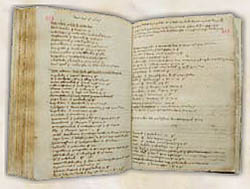 Administrative changes in 1960 caused that the Košice City Archives was ran by the Council of the National County Committee in Košice for a certain period of time. The departure of O.R. Halaga was the main cause of this, aside other (political) reasons. It was not until March 1968 that the mistake of merging the Košice City Archives with the County Archives of Košice was set right.
Administrative changes in 1960 caused that the Košice City Archives was ran by the Council of the National County Committee in Košice for a certain period of time. The departure of O.R. Halaga was the main cause of this, aside other (political) reasons. It was not until March 1968 that the mistake of merging the Košice City Archives with the County Archives of Košice was set right. The Košice City Archives was built and ran by the city for centuries as its historical archives. The archives was assigned to the city of Košice following the political changes after 1989 according to Act No. 518/1990 Coll. "on conveying the establishing and founding function of national committees to a town" coming in force from 1 February 1991. The new amendment on archival science No. 332/1992 Coll. in section II only asserts this fact. It is undoubtedly the credit of Dr. Jozef Kirst director of the Košice City Archives in the years 1975-2011. The city can now keep its historical and archival wealth which has been formed by the city for centuries. The Košice City Archives was receiving transfer payments from the state by fulfilling a state administrative role throughout the years 1991-2002. The state administration material split up from the material of the municipality after the Act No. 495/2002 Coll. on archives and registries had passed. It took over seven years for the archival material to be delimited between the State Archives with regional territorial scope, its branch and the Košice City Archives. Thus, the Košice City Archives became the owner of all documents which originated from activities of former national comittees from 1949 to 1991 in an extent of more than 2000 linear meters. It is embedded in the fundamental law of our state - Constitution of the Slovak Republic - to protect and care about our cultural heritage, of which the archival wealth is an essential component. Every linear meter of archival material which is preserved by the Košice City Archives proves that the archives is fulfilling its role.
Pictures:
1) The great (altar) seal of the city of Košice with its patroness, Saint Elizabeth. Notable charters issued by the city from the beginning of the 14th century until 1504 were seal using this piece
2) Elenchus by Johannes Scheutzlich from the beginning of the 16th century
3) A parchment dust cover on the Elenchus by Johannes Scheutzlich
4) A portrait of the archivist – senator of the city F. A. Schwartzenbach
5) The title sheet of the I. part of F. A. Schwartzenbach's Inventory
6) The original furnishing of the archives from the end of the 18th century, the list of reeves and people's tribunes of the city
7) The archives resided behind these town hall windows for centuries
8) Records in the oldest town book from 1393 to 1405
Text: Mária Hajduová
Photo: Gabriel Szeghy











